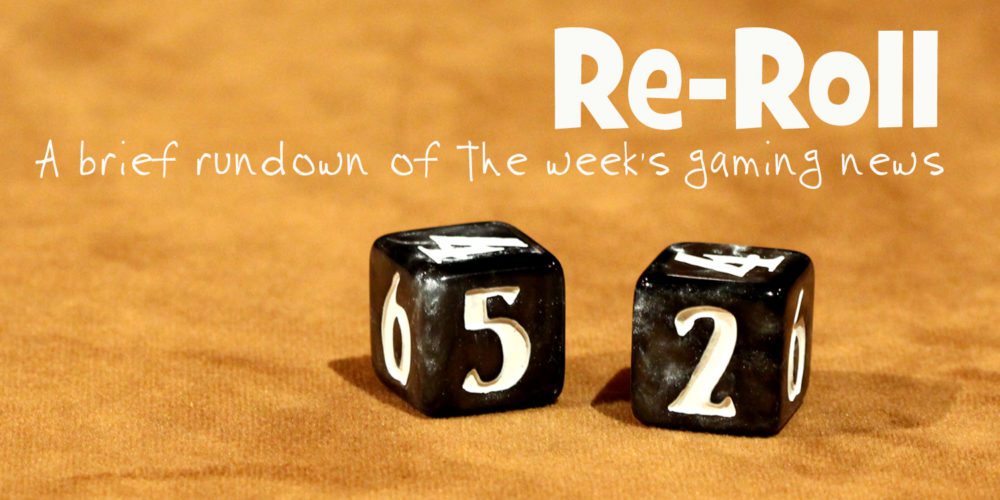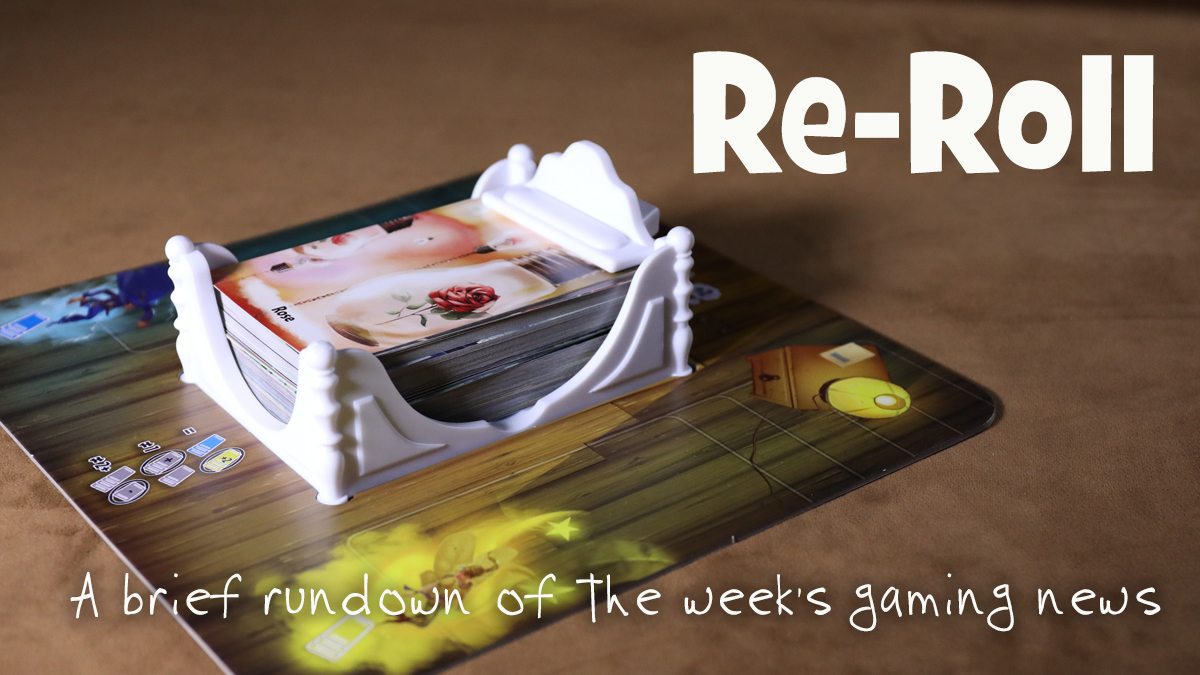As the sun sets, the vampires leave their castle to seek their prey, but they must hurry home before sunrise in this deck-building game.
What Is The Hunger?
The Hunger is a deck-building game for 2 to 6 players, ages 12 and up, and takes about 60 minutes to play. It retails for $50 and available in stores or directly from the publisher. The game is about being vampires, capturing (and sometimes digesting) villagers, though the artwork leans toward caricature, which could make it a little less creepy in case kids are playing.
The Hunger was designed by Richard Garfield and published by Origames and Renegade Games, with illustrations by Jocelyn Millet, Semyon Proskuryakov, Marta Ivanova, and Alexey Bogdanov.

The Hunger Components
Here’s what comes in the box:
- Game board
- 4 Hunt Track boards
- Moon token
- 122 Hunt cards:
- 80 Humans
- 22 Familiars
- 20 Powers
- 3 Rose cards
- 6 Starting decks (6 cards each)
- 6 Vampire sheets
- 6 Vampire tokens
- 6 Scoring tokens
- 50 Mission tiles
- 5 Castle tiles
- 26 Bonus tokens

The board is double-sided, with one side used for the “Rookie” rules and the other side used for the “Elder” rules. The only difference, I think, is that the Rookie side has scoring penalties on the spaces in the mountains and the Elder side does not, but everything else is otherwise the same. The board itself shows a snowy mountain surrounded by a village that spreads out on the plains and then extends into the forest.
The hunt track is assembled from four different boards, and the number you use will depend on the player count.

The six vampire characters have different nationalities—as I mentioned earlier, they’re illustrated in an exaggerated style that fits the somewhat humorous take on the subject matter. The humans range from serious to goofy, and the animal familiars are extremely aggressive. These large cards help you organize your cards—your deck and discard, your current played cards, and your digested humans. I’m not entirely sure why “Playing Area” is upside down, because it’s unlikely you would be rotating this card to turn the illustration sideways. (If you do prefer a vertical orientation, the back of the vampire sheets have a larger portrait of the vampire without the bonus token spaces.)
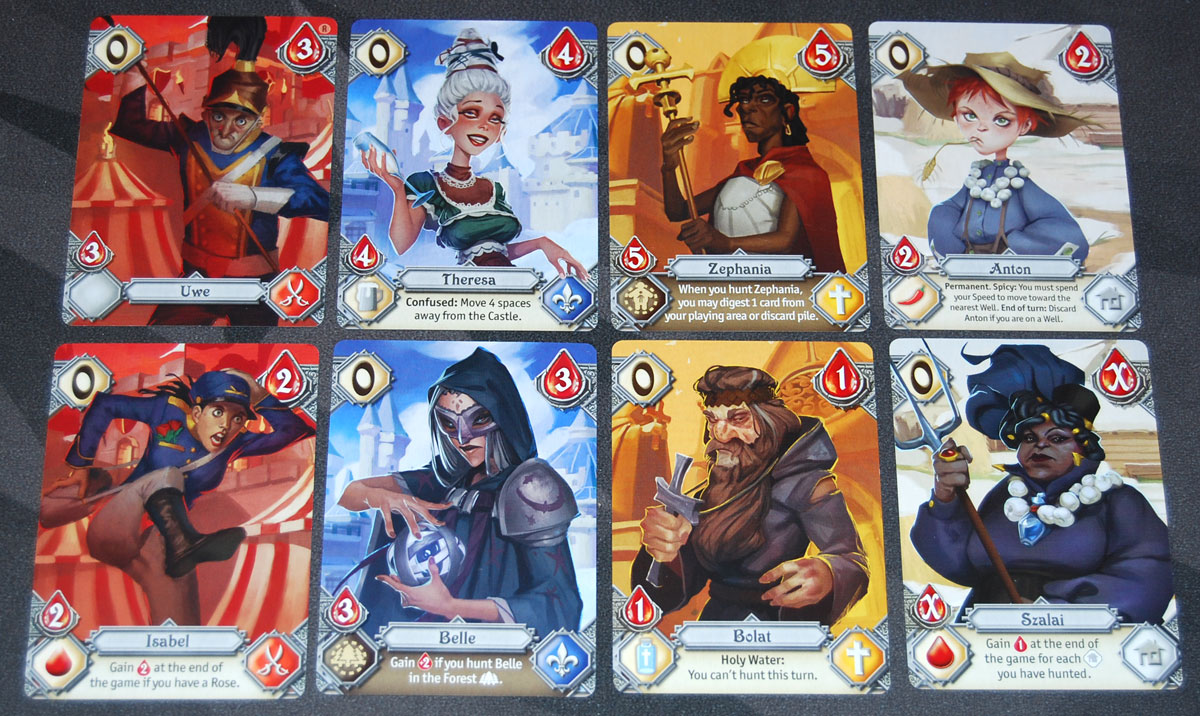
How to Play The Hunger
You can download a copy of the rulebook here.
The Goal
The goal of the game is to score the most points by hunting prey over the course of 15 rounds, and then get back to the castle before sunrise.
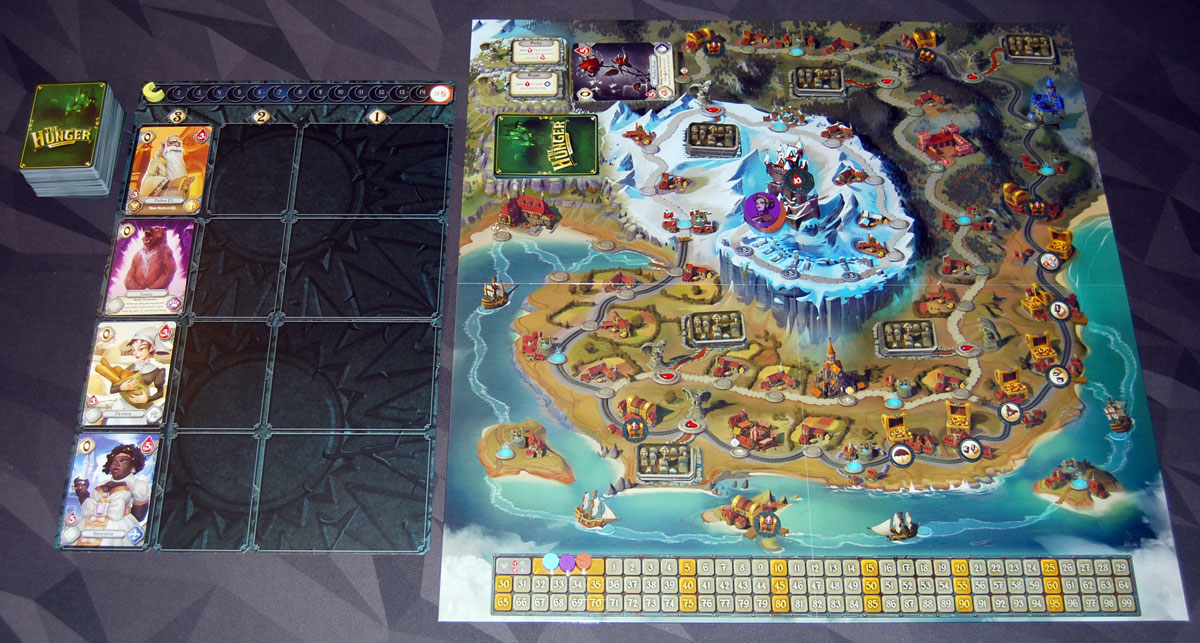
Setup
For the main board, mix up the bonus tokens and place them on all the spaces with a treasure chest; closed chests get a face-down token and open chests get a face-up token. Shuffle the mission tokens and draw two white-title missions to place face-up at the top left of the board. Place a stack of missions in each crypt space as indicated by the number on the crypt. Place the three rose cards in a stack on the labyrinth space, and three random hunt cards face-down in the tavern space.
Set up the hunt track: there should be one more row than there are players. Shuffle the hunt cards and place the deck nearby, drawing cards to fill the leftmost column of the hunt track. Place the moon token on the first space of the round marker.

Each player gets their starting cards, which are marked with an “S” in the top right corner and have their vampire portrait in the bottom left. Each player also draws 2 mission tiles, chooses 1 to keep and discards the other back to the box.
Shuffle your starting cards and draw 3 cards for your first hand, and add up the speed (the large number at top left). The player with the lowest speed will go first: stack the vampire tokens on the castle so that the first player is on top.
Gameplay
In general, turn order each round is determined by how far you are from the castle, and which path you take: Forest, then Plains, then Mountains, then Cemetery (the last few spaces on the mountain next to the castle). If you’re in the same region, the road goes first, then the railroad, and then the boat path. Finally, if you are on the same space, whichever vampire token is on top goes first. After you take your turn, you flip your token face-down, and the round ends after everyone is face-down.
On your turn, you must play all of your cards one at a time and resolve their effects. Cards may have beneficial or harmful effects, as well as a speed value. You total up your speed, and then use it to move and/or hunt.
You may move one space for each speed point you spend, but you may only move in one direction and cannot backtrack, and you trigger the effect of the space you land on. If you land on other vampires, you are allowed to push them to adjacent spaces, but that’s optional. There are various spaces on the board with special effects, but you only get the effect of a space if you moved to the space this turn—if you stayed on your current space without moving, you do not get to use its effect.
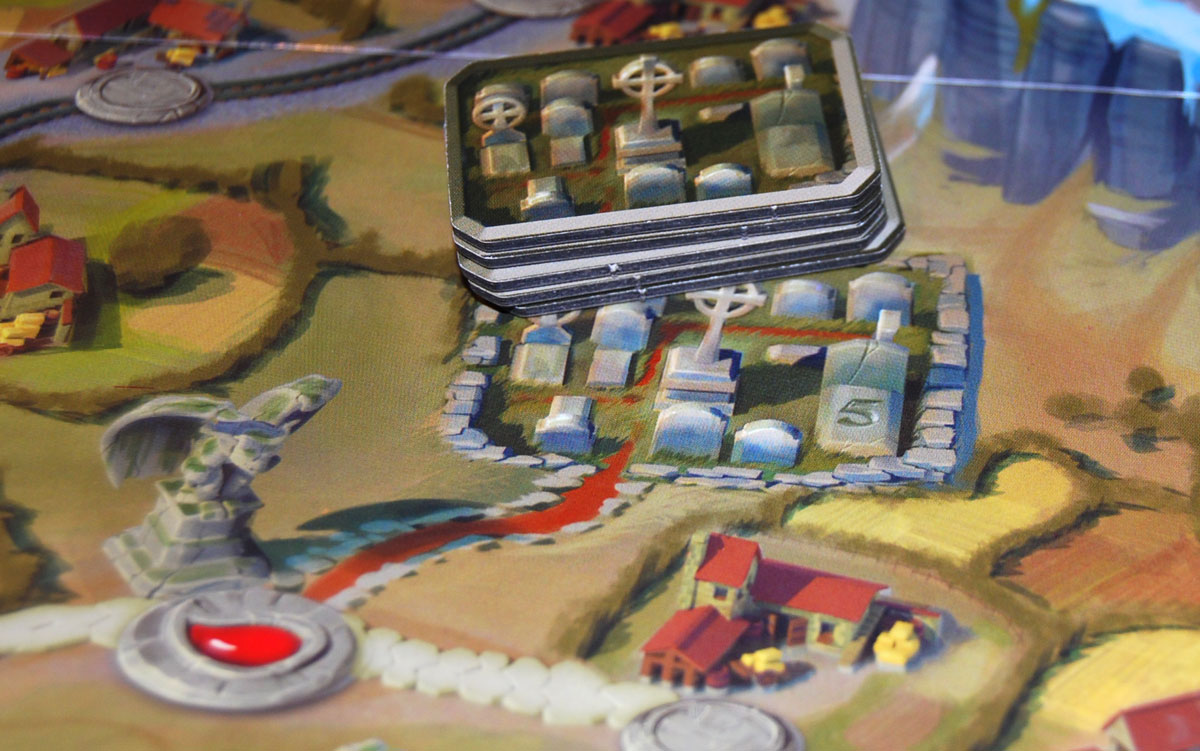
At a crypt space, you may pick up the whole stack of missions to your hand, and then return a number equal to one less than what you picked up. You’ll increase the number of missions you have by 1, but you can trade out with missions that you started with.

The chest spaces have bonus tokens on them—if you land on a space that has a token, you may take it. Every token is worth 2 points when you take it, and they also have an additional effect.
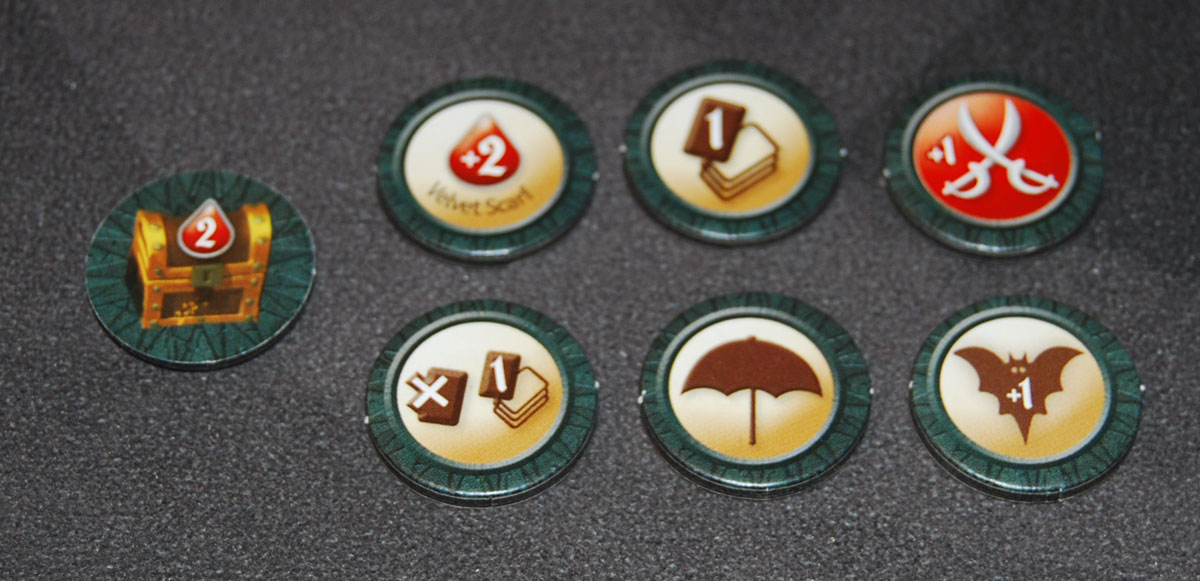
Tokens may be played on your turn for their effects and are flipped face-down to indicate that you’ve used them. You might get to draw an extra card, hunt an additional time, or get an extra turn in the sun before burning up by using a parasol. Or, you might just get some extra points for having some velvet clothing.
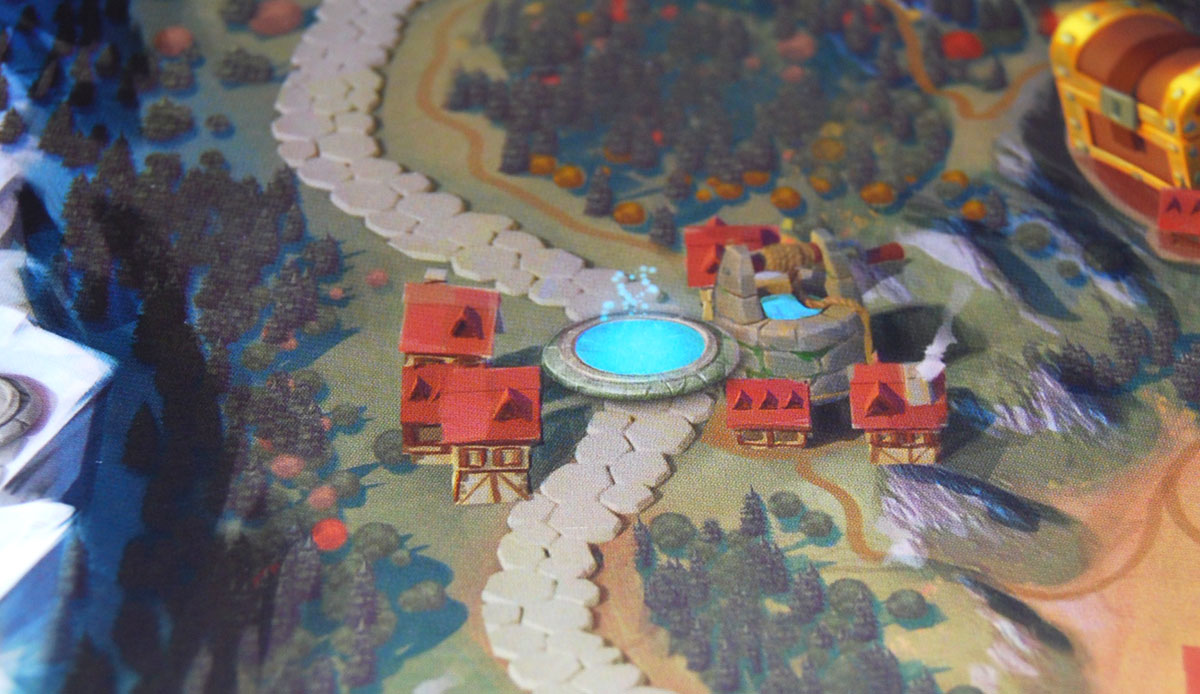
The wells are blue spaces, and allow you an extra hunt action on your turn, but the extra hunt may only be spent in the “1” column of the hunt track. There are some vampire powers that also refer to wells.

If you land on the Tavern, you can hunt all of the cards in this space for 2 speed instead of your regular hunt action—but you must take all of the cards in the stack.

If you make it all the way to the end of the path to the labyrinth space, you may use your hunt action to claim one of the rose cards there, if any are left. Each rose has its own effect and is immediately placed in front of you face-up. You may only have one rose card.
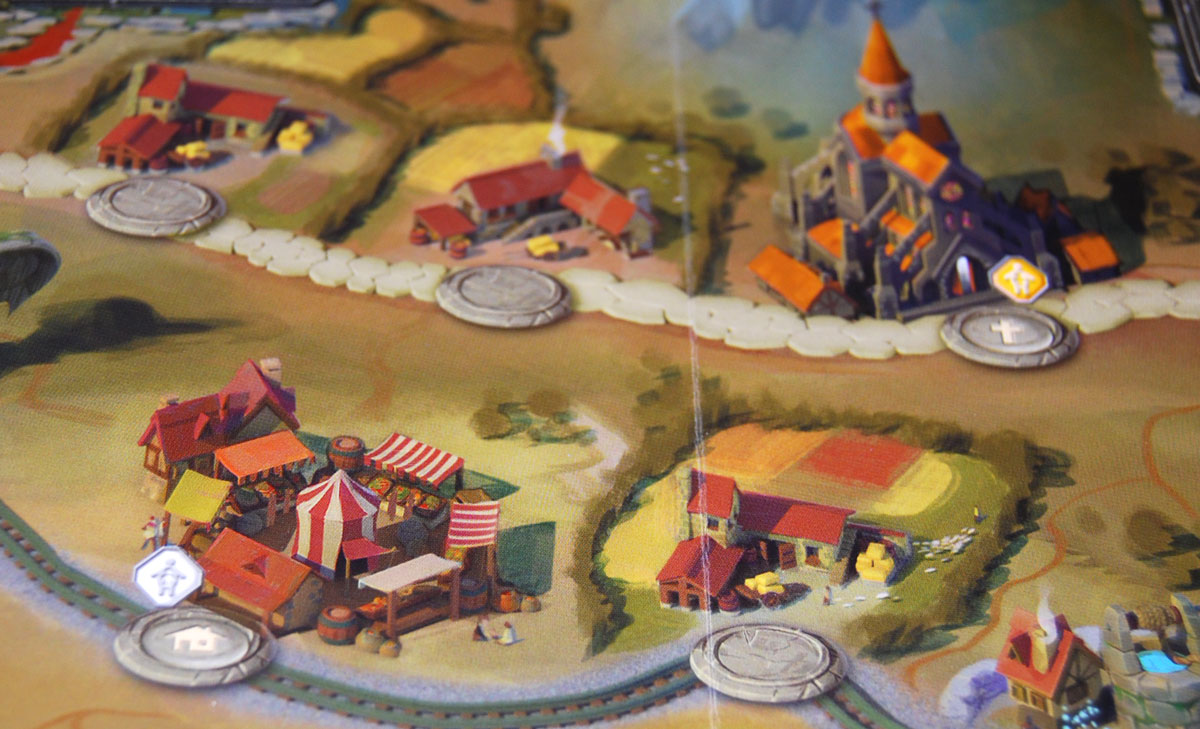
There are four spaces on the board—one for each category of human—that allow you to digest a human of the corresponding category. You remove the human from your discard pile or playing area, and place it in a “digest” stack. You’ll still score points for that human at the end of the game, but they’ll no longer slow you down.
After moving, you may hunt once.

With any speed you have remaining, you may hunt one space on the hunt track, taking those cards and putting them into your discard pile. The first column (the newest cards) cost 3 speed, the middle column costs 2 speed, and the rightmost column costs 1 speed. Each space in the last column can hold any number of cards, and if you choose that space, you must take all of the cards in the space. Once you’ve hunted, any remaining speed is lost. You immediately score points for humans you caught this turn according to the blood drop icon. In addition, you score 1 bonus point for hunting in the plains, and 2 bonus points for hunting in the forest.
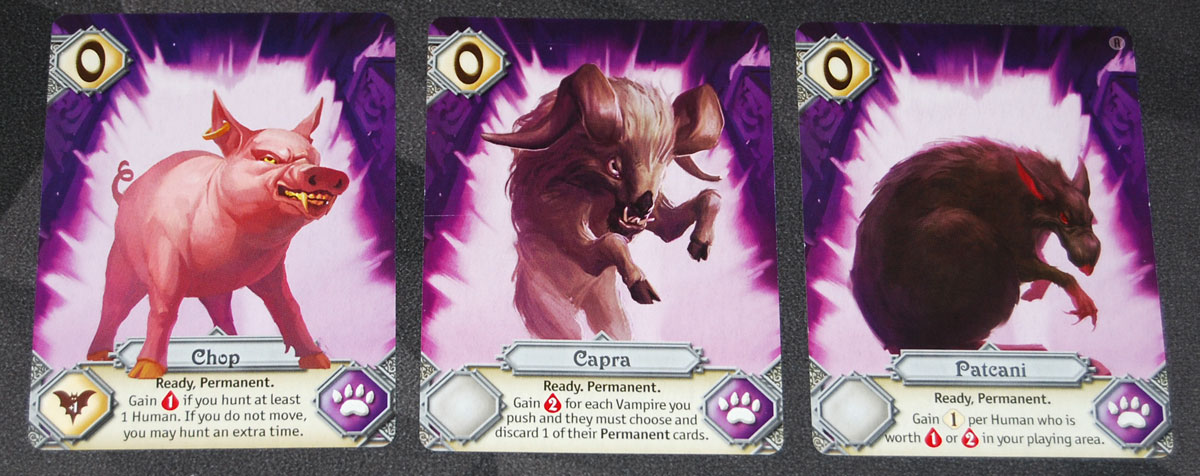
Once you play a familiar—an animal companion—it stays in play, face-up, and continues to give its ability every turn. They have varying effects and can be extremely useful.
At the end of your turn, flip your vampire token face-down, discard all of your cards (except “Permanent” cards), and then use any end-of-turn effects. Draw 3 cards, reshuffling your discard pile if necessary.
If everyone has taken a turn, then the moon tracker is moved ahead one space and everyone flips their vampire tokens face-up. Move all remaining cards on the hunt track 1 space to the right (cards in the rightmost column stay put), and refill the “3” column of the hunt track. If there are no vampires and fewer than 3 cards at the Tavern, draw a card and add it face-down.
Game End
If the moon reaches space 15, any players who have a parasol token may take one final turn. (Multiple parasols do not give you multiple bonus turns.) Then the game ends.
Any players who did not make it back to the mountain burn up in the sun—you can count your points but you aren’t around to enjoy your victory.
If you’re in the mountains in Rookie mode, you suffer a scoring penalty based on how far you are from the castle, as printed on the board. In Elder mode, vampires in the mountain are also burned to a crisp.
If you’re in the cemetery, you lose 5 points.
If you make it back to the castle, you are safe—also, you get a bonus point when you reach the castle. The faster you return, the higher the bonus. (Once you return to the castle, you aren’t allowed to leave again.)

You score points for missions that you’ve achieved. These often have to do with humans you have hunted, but there are various different types of missions. Everyone who meets the requirements of the public missions (at the top of the board) scores points for them.
You also add any points for cards you’ve hunted that have end-of-game bonuses.
The player with the most points wins, with ties going to the player who reached the castle first (or got closest to the castle, if nobody reached it).
Why You Should Play The Hunger
I know we already shared our list of Halloween games last week, but I had just a few more that didn’t quite make the deadline. Here’s one of them!
One of my favorite games (especially for new gamers) is Deep Sea Adventure from Oink Games. It’s a tiny box that I can take just about anywhere, it’s very easy to teach, and it has an absurd story that I find delightful: you’re all deep-sea divers, trying to collect the most valuable treasure, but you all share one oxygen tank. The more treasure you’re carrying, the slower you move, and the more oxygen you breathe. It’s a push-your-luck game where you get to decide when to turn around and head back to the submarine, but it’s not uncommon for everyone to pass out because they got too greedy and the air ran out.
The Hunger reminds me of Deep Sea Adventure because it’s also a press-your-luck game: you want to hunt as many humans as possible and bring them back to your castle, but the more humans you’ve gathered up, the slower you may be. It’s quite possible that on some turns you may not have any speed at all, if you draw a bunch of humans from your deck. But, as with Deep Sea Adventure, there are a lot of things tempting you to go just a little bit further, even though you see the sunrise approaching on the horizon.
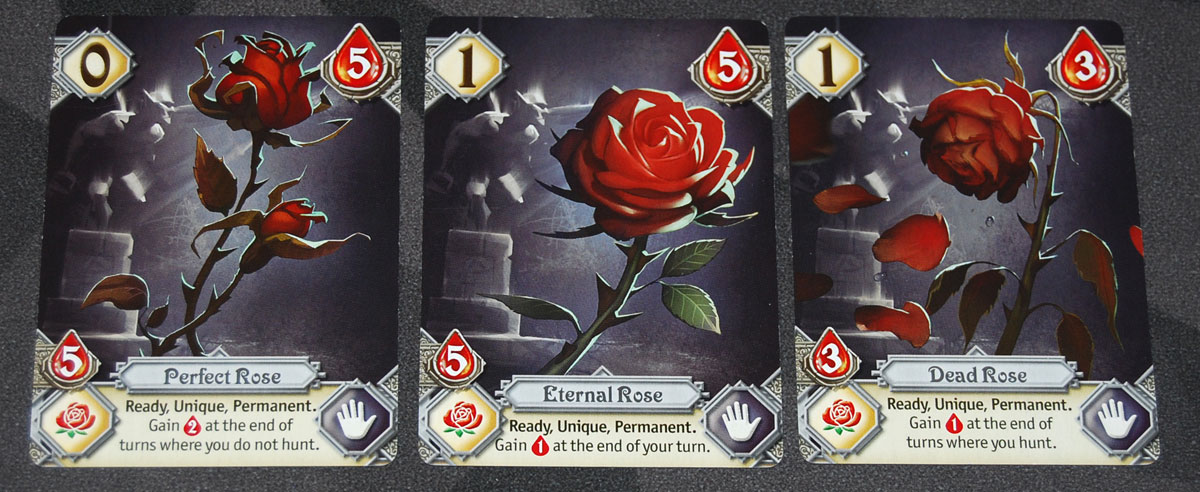
Should you run all the way through the forest to pluck a single rose from the labyrinth? Is that even a question? How could you turn down this perfect rose? Or maybe you prefer the reminder that life is fleeting, represented by the dead rose? One gives you bonus points when you don’t hunt; one gives you bonus points for hunting.
Getting as far as the forest has other benefits as well—you get more points for each human hunted there, and there are also some spaces that will allow you to digest military and noble humans. You don’t know what a pain it is, corralling this big crowd of humans around. There aren’t many places you can get away with feasting on them out in the open—I mean, you don’t want to spook them, right?—but one less human to herd can really speed up the whole group.
Unlike most deck-building games, you only draw 3 cards for your turn. There are some cards or effects that let you draw more, but for the most part you have a fairly limited set on each turn. Getting enough speed to move far and hunt can be difficult, and the more you hunt, the lower your average speed tends to be. Figuring out the balance, and how many turns you need to get back to the castle, can mean the difference between victory and ashes.

The hunt deck also includes some vampire power cards (the green ones). Some let you move more quickly, some let you manipulate your deck a bit more, and some even let you move things around on the hunt track so you can maximize your hunts.
The humans have some fun effects as well. For instance, the three types that show up in the “Dangerous Diet” mission are confused, spicy, and holy water. The confused human (okay, they’re clearly drunk based on the illustrations) force you to move away from the castle—great during the first half of the game when you want to run toward the labyrinth, but terrible if you’re trying to get home. The spicy humans force you to move toward the closest well until you reach it to quench your thirst. And the humans carrying holy water prevent you from hunting for a turn. They’re worth more points, but are they worth the trouble?
Obviously, The Hunger is a lot more complex than Deep Sea Adventure, with a lot more moving parts and tactical decisions to make. But at its core, it comes down to the same thing: a choice between greed and safety. You aren’t just playing against other players—you’re playing against your own hubris. I’ve enjoyed the humor of The Hunger, even when I’ve met the sunrise just outside the cemetery walls and crumbled to dust.
For more information or to order a copy of The Hunger, visit the Renegade Games website.
Click here to see all our tabletop game reviews.
![]() To subscribe to GeekDad’s tabletop gaming coverage, please copy this link and add it to your RSS reader.
To subscribe to GeekDad’s tabletop gaming coverage, please copy this link and add it to your RSS reader.
Disclosure: GeekDad received a copy of this game for review purposes.



